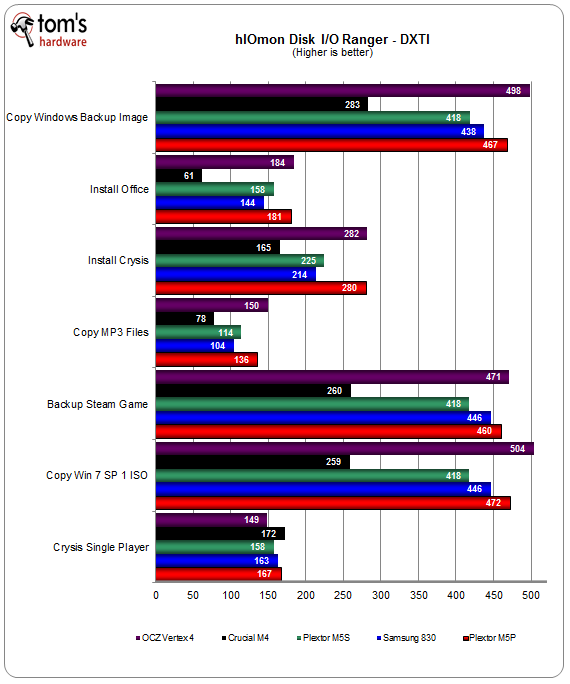Plextor M5 Pro 256 GB Review: 19 nm NAND And Marvell's Latest
Hot on the heels of its M5S, Plextor sent us the M5 Pro. Loaded with hot new technologies like 19 nm NAND and the latest Marvell controller, the company's flagship was certainly worth waiting for. How does it do against the established incumbents, though?
Monitoring Transfers With hIOmon's Disk I/O Ranger
With ASU behind us, we dive into hIOmon, which helps rate the performance of file transfers and application installations using a “Data Transferred/Time Index (DXTI).” This gives us a high-level means for comparing I/O performance. A higher index corresponds to better performance (more data transferred and/or lower response time).
The hIOmon DXTI is calculated by taking the observed amount of data transferred, using the I/O operations converted to megabytes for scaling, and dividing by the combined sum of the actual response times of those same I/O operations. What you end up with is a lot like a car's fuel economy index insofar as it conveys performance efficiency. It is comparable to more miles driven (more data transferred) for fuel used (response time taken to transfer this data). Or, it could represent the same number of miles driven (data transferred) using less fuel (lower response time).
This software can be configured to monitor at the physical volume level, located between the file system and the volume manager. This gives us an indication of I/O performance below the file system and closer to the storage device within the constraints of the operating system.
The procedure we run through goes as follows:
- Copy MP3 files: 47 695 MiB written (6663 files in 353 folders).
- Copy Windows image backup: 14 875 MiB written (16 files in four folders).
- Copy Windows 7 SP1 ISO file: 1953 MiB written
- Install Crysis: 2103 MiB written
- Install Office: 1174 MiB written
- Back-up Steam game: 14 246 MiB written
- Run antivirus scan: 365 MiB read
- Play Crysis single-player: 813 MiB read
The tasks we chose are all write-intensive, with the exception of the Crysis single-player campaign. Therefore, we are primarily looking at write performance in a real-world environment. The combined activity results in just over 80 GiB of capacity written to on each drive. The reason this matters during our benchmark analysis will be explained further in the results from our HD Tune Benchmark tests.
The Vertex 4 dominates all of the tasks, aside from the only read-intensive workload, where it finishes in last place.
Plextor's M5 Pro does significantly better than the M5S, and simultaneously beats Samsumg's 830 and Crucial's m4 in everything except the read-intensive task, where Crucial's m4 comes out on top.
Get Tom's Hardware's best news and in-depth reviews, straight to your inbox.
The Crysis single-player campaign consists of random and sequential read operations, roughly split down the middle, with 80% of the data transferred by sequential operations.
Frankly, we're a little surprised that Crucial's drive does so well here, since the synthetic read performance results indicate that Plextor's M5 Pro should be superior.
Current page: Monitoring Transfers With hIOmon's Disk I/O Ranger
Prev Page Benchmark Results: Anvil's Storage Utility Next Page Benchmark Results: HD Tune-
You have the wrong Marvell controller listed for the crucial M4 and the Plextor M5S. This controller is new.Reply
The old one was the 88SS9174-BKK2.
http://www.tomshardware.com/reviews/plextor-m3-crucial-m4-octane-performance-pro,3178.html -
mayankleoboy1 can we have a benchmark of the time it takes to install a fresh copy of Win7+SP1 on a SSD ? Because thats the first thing a user will do after buying a new drive.Reply -
echondo mayankleoboy1can we have a benchmark of the time it takes to install a fresh copy of Win7+SP1 on a SSD ? Because thats the first thing a user will do after buying a new drive.Reply
I believe we can all assume it will take around 10-15 minutes. My old SATA2 Vertex drive can have Windows installed with all the Windows updates I want in around 20 minutes, it would be less time but I have to install all my drivers first for my motherboard :p -
SpadeM grantwarI'd love to see how this drive fares against the samsung 840 Pro.Reply
Here you go:
http://www.anandtech.com/bench/Product/665?vs=646 -
JeanLuc I was on Youtube the other day on the Corsair channel and they were showing the advantages of 'Ram cache' which was lights years faster then SSD's in therms of throughput. Could Toms consider doing an article into Ram cache as I think it would be of interest to people who have 16-32Gb systems (since DDR3 is cheap at the moment) can spare the extra system ram to cache files and software.Reply -
merikafyeah SpadeMHere you go: http://www.anandtech.com/bench/Product/665?vs=646Wow. The 840 Pro beat the M5 Pro in virtually everything according to that data. The 840 Pro does cost significantly more though.Reply -
merikafyeah JeanLucI was on Youtube the other day on the Corsair channel and they were showing the advantages of 'Ram cache' which was lights years faster then SSD's in therms of throughput. Could Toms consider doing an article into Ram cache as I think it would be of interest to people who have 16-32Gb systems (since DDR3 is cheap at the moment) can spare the extra system ram to cache files and software.TheSSDReview did something similar:Reply
http://thessdreview.com/our-reviews/romex-fancycache-review-ssd-performance-at-13gbs-and-765000-iops-in-60-seconds-flat/
No point in even comparing RAM to SSDs, as even "slow" RAM is faster than even the best SSDs by about the same amount as the best SSDs are faster than floppy disks. -
aicom This review would have been impressive if it was published 2 weeks ago. With the 840 Pro out, it simply blows the M5P out of the water. Too bad it wasn't included in the benchmark charts here.Reply
